How to position axles to stay legal: Driver’s Education
Cargo weight must be distributed evenly across all your axles. And sometimes you have to slide your axles or 5th wheel to redistribute the weight in the trailer. Here’s a guide to basic axle weight rules across North America, and a how-to on repositioning axles to get the weight to where it needs to be.
As you pull out from the loading dock, you can’t help but notice that you have a good load on. The engine labors more than usual, and the truck just feels heavy.
According to the bill of lading, you have 45,500 lb. in the box. You wonder if that weight includes the 24 pallets. That would be an additional 500 lb. or so. Either way, you’re going to be close to maximum gross weight, and that means you’ll be tight on the axle weights, too.
On the way to the truck stop to axle weigh the truck, you’re thinking it was a good thing you went in to load with just a third of a tank of fuel. That’s 750 lb. you won’t need to worry about.
Weighing the truck, you discover the drive axles are overloaded, but you still have some room on the steer axle and the trailer axles. Let’s say your scale ticket looks like this: The steer is 12,000 lb.; drive 35,000 lb.; trailer 32,000 lb.; and gross, 79,000 lb.
Options to adjust weight
You have a couple of options. Slide the trailer axles forward so they will pick up some of the excess drive axle weight. Or slide the 5th wheel ahead to transfer 1,000 lb. from the drives to the steer axle.
If you have a 13.2K steer axle with the appropriate tires, you have room for an additional 1,200 lb., but doing that leaves little room for additional fuel.
The drive axles can handle the weight from sliding the trailer axles forward. The steer axle weight won’t change, so you’ll have room for more fuel.
What happens when you move axles?
Moving the trailer axles forward changes the way the weight is distributed over the center point of the axle. It acts as a fulcrum, like the center bar on a playground’s teeter-totter.
If more of the weight is placed further behind the fulcrum, the center point will bear more of the weight, lightening the load at front (the drive axles).
So how far forward should you slide the trailer axle? In this case, you need to move at least 1,000 lb. off the drive axles, but you have room on the trailer axles for an additional 2,000 lb.
Dane Arcand, a truck driving instructor at Transport Training Centres of Canada’s Ottawa campus, uses a rule of thumb that suggests about 100 pounds per inch of travel on the slider.
“If your slider has locking holes at six-inch centers, you will shift about 500 pounds per hole,” he says. “If the hole spacing is three inches, they are good for about 250 pounds.”
If you make notes each time you slide your axles, you soon have a better picture of how much weight is transferred per inch of travel.
In this case, you probably need to slide the axle forward between 12 and 18 inches. Depending on the slider on your trailer that could two to four holes.
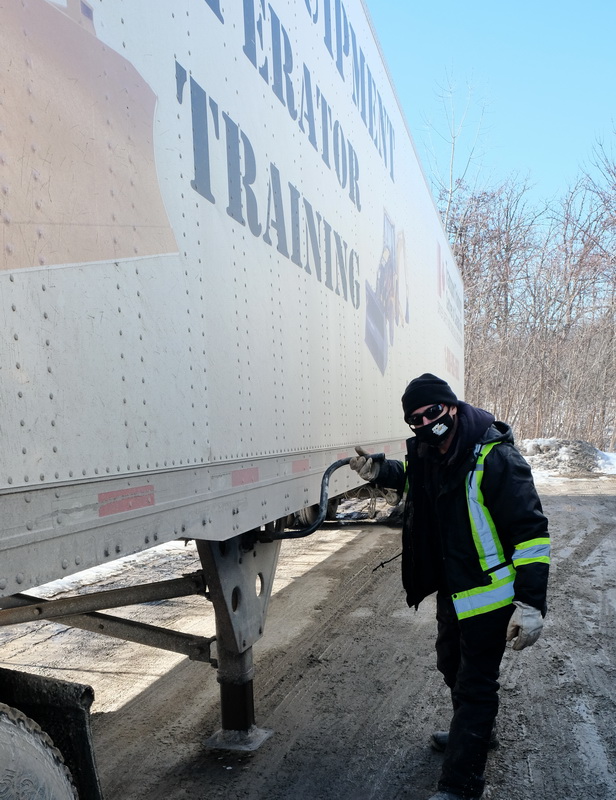
Another example of overloaded axles
Let’s look at another example. This time the trailer axles are overloaded by 1,000 lb. The steer is at 12,000 lb.; drive at 32,000 lb., trailer at 35,000 lb.; and gross at 79,000 lb.
Options are limited in this case. You will have to slide the trailer axles back.
Some of the weight transferred to the drive axles will shift to the steer axle. And sliding the trailer axle back too far could violate the kingpin-to-rear-axle restrictions.
Since you want to take weight off the trailer axles, you need to move them further away from the center of the load, so you will need to slide them back 12-18 inches, or two to four holes on the slider rail.
But there’s a limit to how far back you can go. To maintain maneuverability and reduce off-tracking of 53-foot trailers while turning, states and provinces limit the allowable distance between the trailer kingpin and the center of the rear axle (the hub) in the tandem group.
That distance varies across different jurisdictions (what a surprise), with California being the most restrictive at 40 feet (12.2 m). Signatories to the Canadian MOU on Vehicle Weights and Dimensions allow 41 feet (12.5 m).
As a word of caution. If, staying with this example, you have a 12K steer axle loaded to 12,000 lb., and you slide some weight from the trailer axles forward onto the drive axles, the weight of the steer axle is likely to increase slightly as well. You may have to slide the 5th wheel back slightly to keep that weight off the steer axle.
Moving the weight around
Before sliding anything, mark your starting point, Arcand suggests.
“If you know you need to move it 12 inches, you’ll need to know where you’re starting from and where you want to wind up,” he says. “It’s difficult to move the axle or the 5th wheel precisely when you can’t really see what you’re doing from the cab. It helps to have someone spotting for you, but if you’re alone you may have to keep cinching it back and forth until you get close, then engage the lock and carefully slide it until the lock catches in the frame.”
Before attempting to slide, look to see the locks have disengaged and will slide freely. You may have to shuttle the truck forward and backward with the trailer brakes engaged to free up the mechanism. And since you’re loaded, that may take some deft clutch work with a manual transmission or careful throttle application with an automated transmission.
“You don’t want to use a lot of throttle because, when it breaks free, it will keep on going until you stop it,” he says. “I have seen photos online where drivers slid the trailer tandems right out from under the trailer.”
If they seem stuck, driving around on some uneven ground can help, or try rolling the truck forward or backward and then sharply applying the trailer brakes.
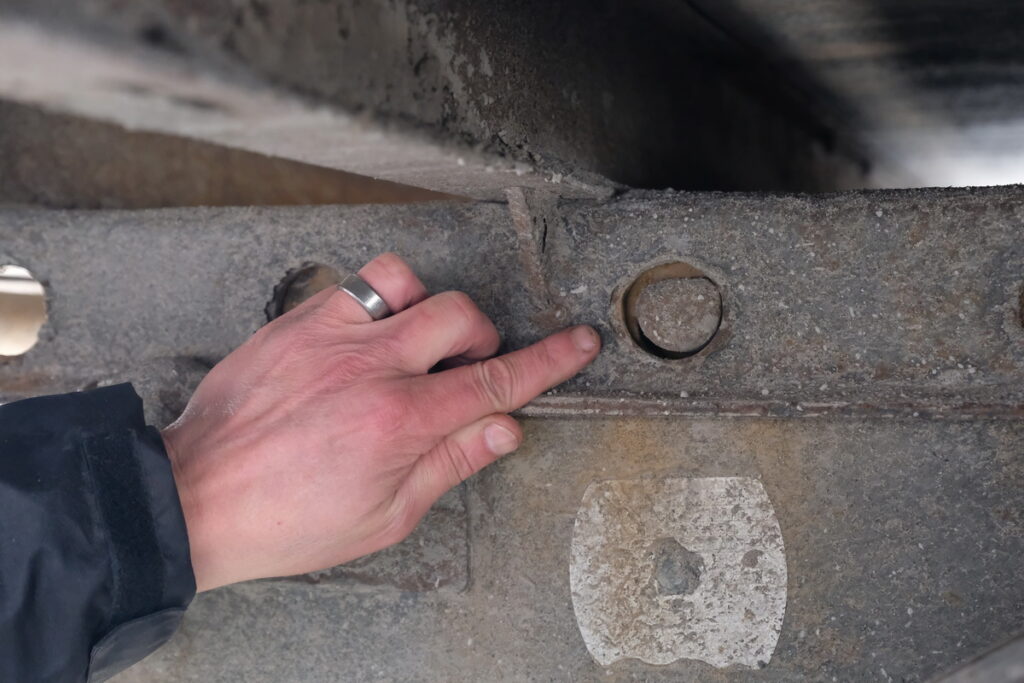
Will locks work and axles slide?
It helps to make sure the locks work and the axles will slide before you load — while the trailer is empty — just for peace of mind that the mechanism is working. Arcan stressed the importance of “exercising” the slider locks periodically.
“They can get rusted into place or can get jammed up with grease from the 5th wheel or grit and debris from the road,” he says. “Lock and unlock them occasionally and move the slider back and forth once in a while so you know they will work when you need them to.”
When sliding the 5th wheel, it helps to take the weight off the tractor frame by lowering the landing gear. Arcand suggests setting the trailer parking brakes and then lowering the landing gear until the pads touch the ground. Then crank the legs down a few more turns until you can hear a hissing sound from the suspension. Give the landing gear crank a few more turns and you will have lifted much of the weight off the tractor suspension and the 5th wheel will slide more easily.
Release the tractor parking brakes (not the trailer brakes) and the 5th-wheel lock, and gently rock the truck back and forth until the locks release. Slide the 5th wheel to the desired position. Get out and look to ensure it’s in the right place, then re-engage the locks. Shuttle the truck back and forth gently until you hear the locks clank into place. Get out and look again to ensure the locks have returned to the locked position.
Set the tractor parking brakes and crank up the landing gear and go re-weigh the truck.
Arcand advises against deflating the tractor air suspension, because doing so drops the frame height by 4-6 inches. That could leave the tractor dangling from the kingpin, which could damage the 5th wheel.
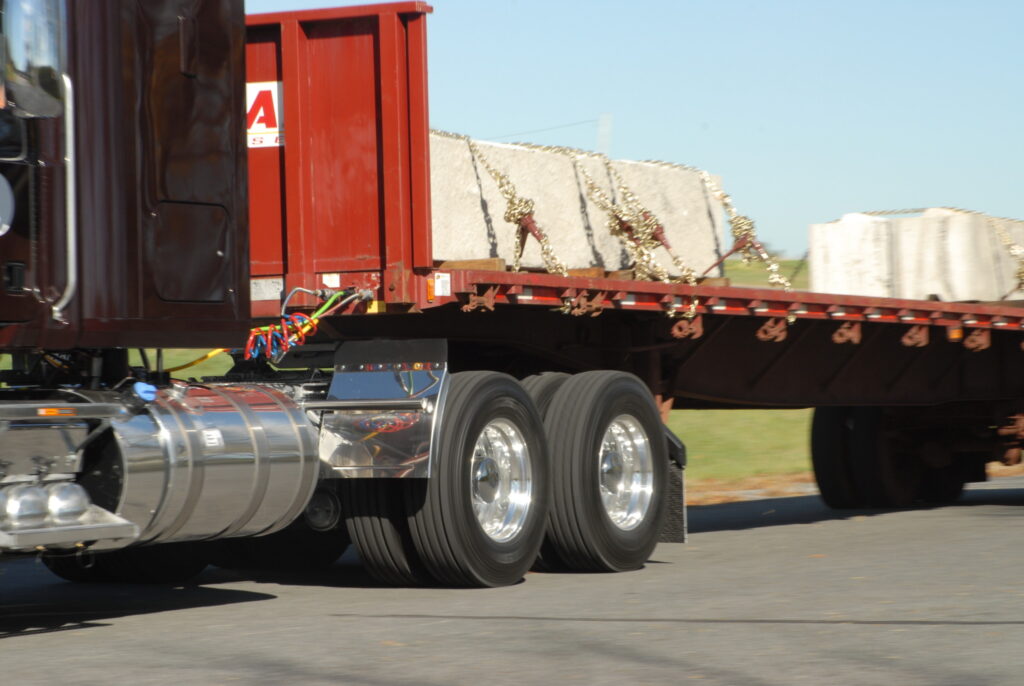
Tips to achieve accurate axle weights
While every load is different, and weights will vary each time you put something in the box, getting the truck into a typical or normal configuration prior to loading will improve your chances of driving away without having to redistribute the weight.
If the load is light, you probably won’t have to worry at all about weight distribution, unless the loader stuffs everything into the front of the box.
Start with the tanks full of fuel and put the 5th wheel and trailer tandems into a “normal” position as a starting point.
- If you have a sliding 5th wheel, position it about two to four inches (5-10 cm) ahead of the center of the drive axles with a setback-axle aero truck. With a long-nose truck, position the 5th wheel about 8-10 inches (20-25 cm) ahead of center.
- With a 53-foot trailer, position the tandems so that distance between the trailer kingpin (the pivot point of the 5th wheel) and hub of the tandem’s rear axle is 40 feet (12.2 m). That should position the rear axle about eight-10 feet from the back of the trailer — and keep you under the maximum allowable kingpin-to-tandem distance in most states and Canada.
- Most trailers weigh about the same, but they many use four-inch or six-inch holes in the slider. Rather than count the holes, measure the distance from the back of the trailer to the center of the rear axle hub.
- Take pictures or makes notes of these positions so you have a record of your starting point.
If you configure the truck like this each time before you load, you’ll have a consistent starting point.
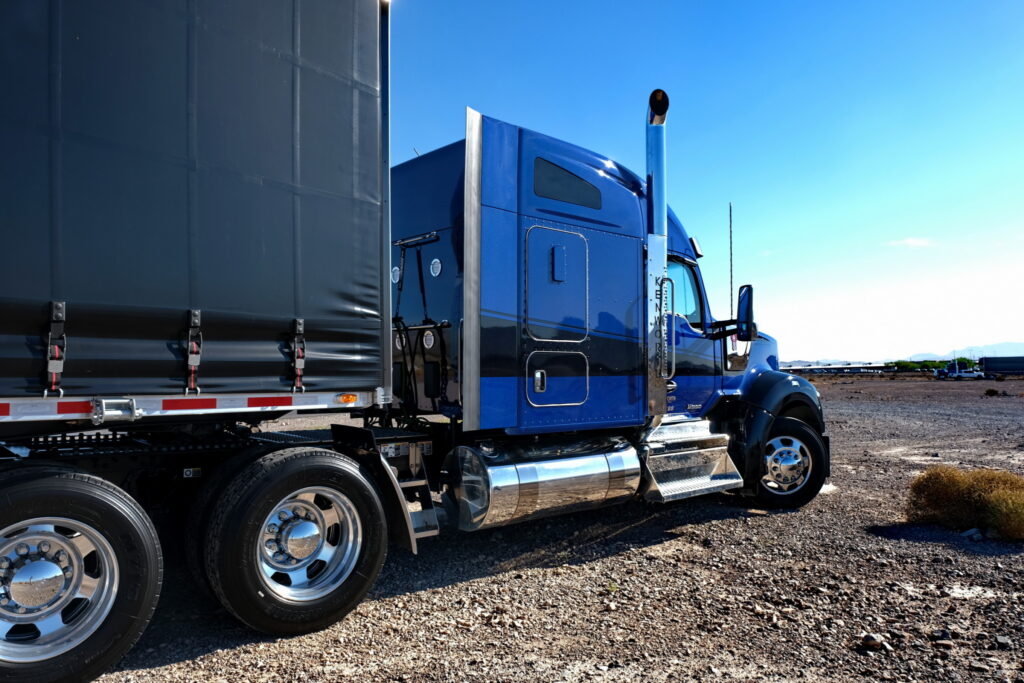
How does fuel affect axle weights?
It’s much easier to slide things when the trailer is empty, and if you discover a problem with the slider mechanism, you’ll be able to deal with it before you load.
Sometime when you are empty and preparing to refuel, axle weigh the truck before you fuel, record how much fuel you took on, and reweigh the truck. This will tell you how the weight of the fuel distributes itself between the steer and the drive axles.
That’s useful knowledge when taking on a heavy load that could put you over on your tractor axle weights if your tanks are full. It also helps to know how much fuel you can take on if you have a heavy load and your axles are close to maximum.
For an aero truck with set-forward fuel tanks, about 80% of the fuel’s weight will go on the steer axle, and 20% to the drives. With a long nose and rear-mounted tanks, about 70% will go to the drive axles and 30% will show up on the steer axle. Your own results may vary.
Diesel fuel weighs about 7.5 lb. per U.S. gallon (0.85 kg/L or 1.8 lb./L). If you take on 100 U.S. gallons, your weight will increase by about 750 lb. (340 kg). The tank locations will determine where the weight goes. As per the aero-truck example above, about 600 lb. will wind up on the steer axle, 150 lb. on the drives.
Keep a record of your previous load’s axle weights so you’ll get to know how the weight is distributed on the axles. This will reduce future guesswork and save you a lot of manual labor getting legal.
-

Even though your load is less than the allowable gross vehicle weight, the load must be evenly distributed across all the axles, steer, drivers and trailer. (Photo: Jim Park) -

Long-nose classic-style trucks tend to load heavier on the drive axles and lighter on the steer axle. (Photo: Jim Park) -
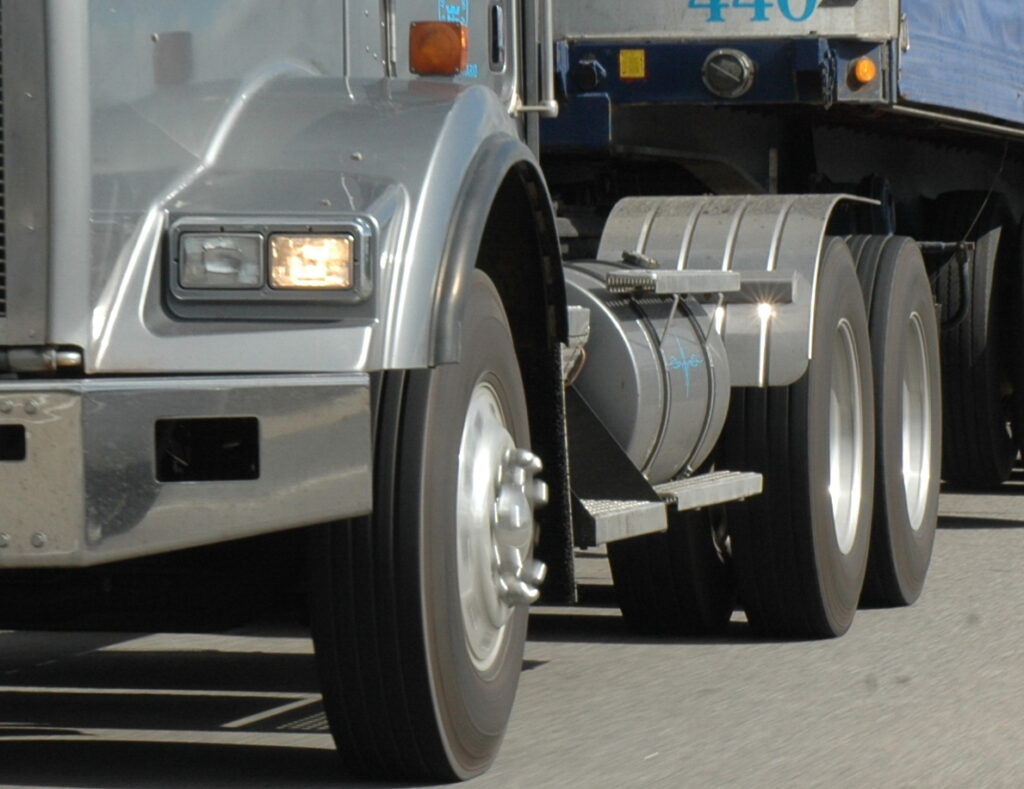
Steer axles on aero cabs are often rated for 13,200 pounds because more of the truck’s weight sist on the steer axle, compared to a long-nose classic truck. (Photo: Jim Park) -
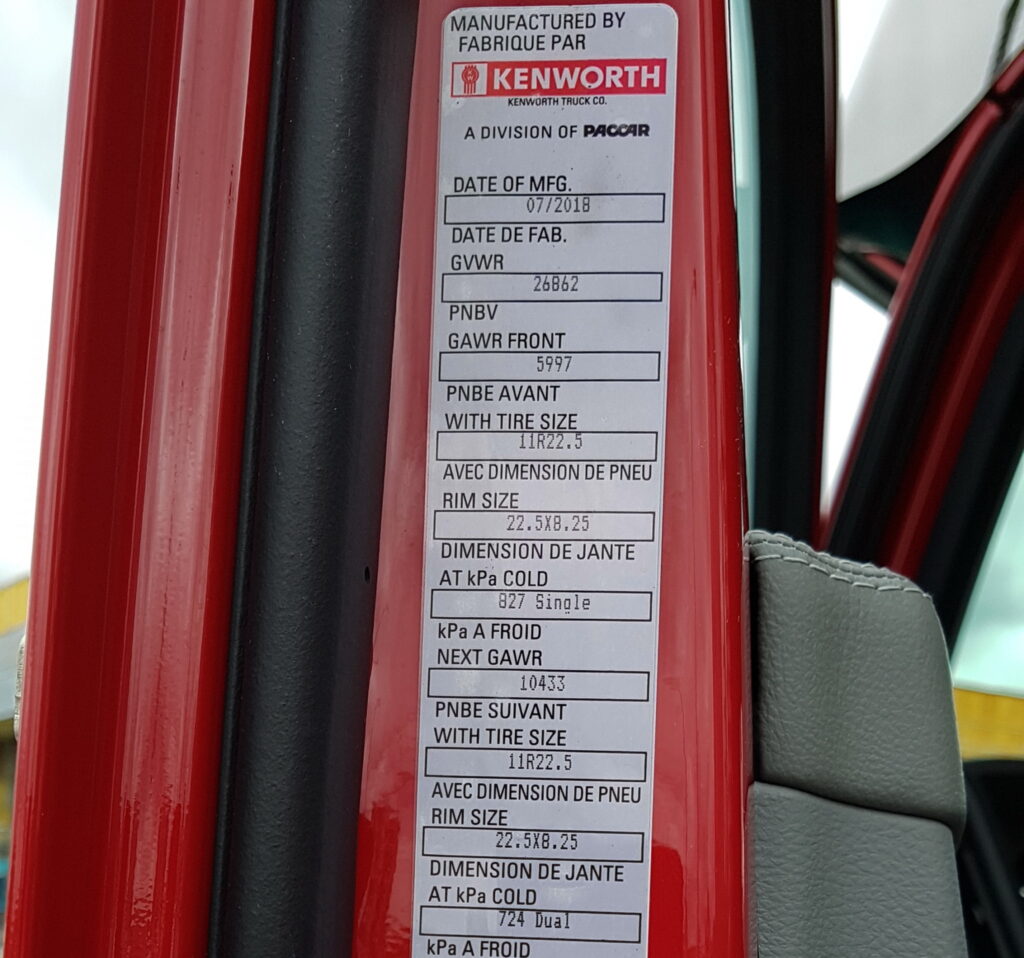
Truck makers place weight ratings stickers on the driver side door post. It displays the tractor’s axle and vehicle weight ratings. (Photo: Jim Park) -

Truck driving instructor, Brendan Bell of Transport Training Centres of Canada’s St. Catharines Campus, dollies-down, preparing to slide the 5th Wheel. (Photo: Jim Park) -

Before attempting to slide the trailer axles, ensure the locking pins are disengaged. (Photo: Jim Park) -
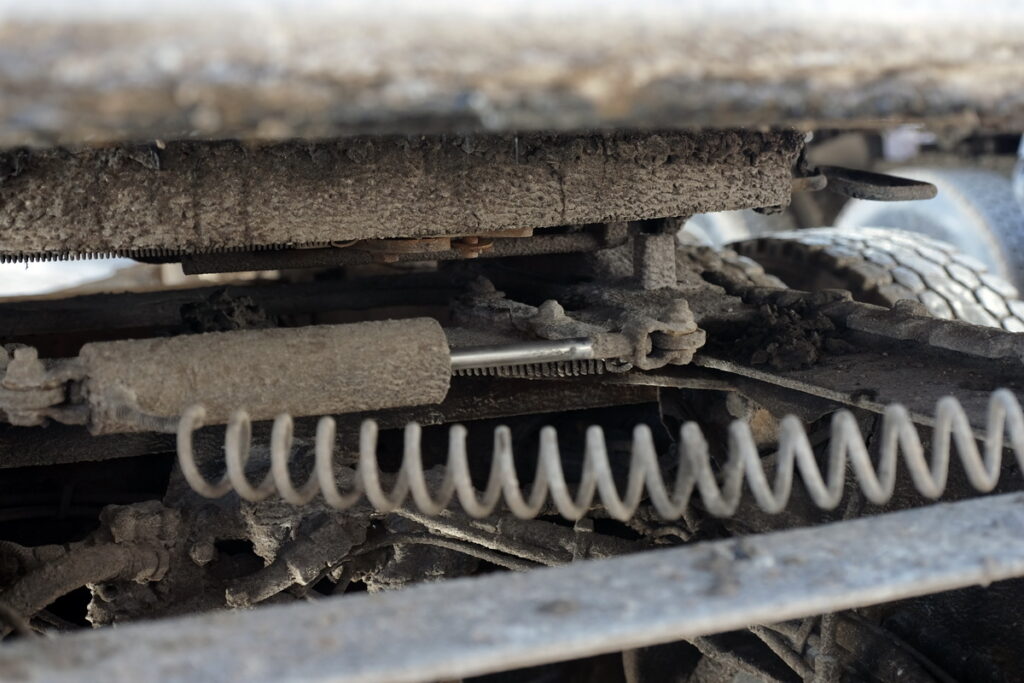
The slider lock release mechanism must be fully extended. These can bind or leak of they aren’t used frequently. (Photo: Jim Park) -

Depending on the brand of 5th wheel, the locking pins may look different. They retract from the slider rail when they are unlocked. (Photo: Jim Park) -
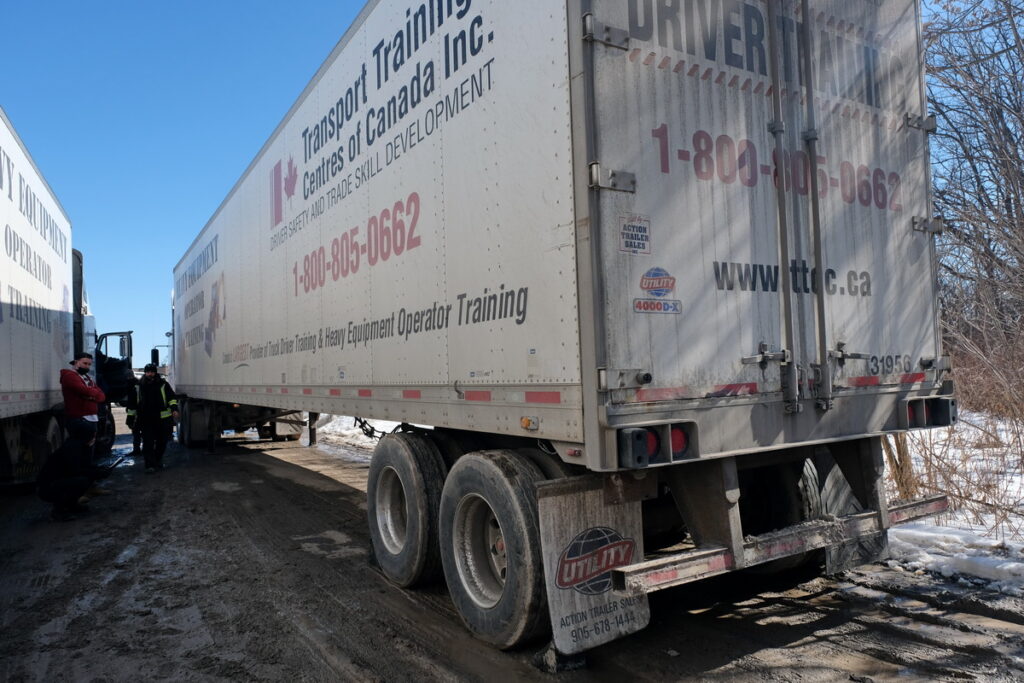
If the trailer axles are positioned too far back, you will exceed the maximum kingpin-to-axle distance of 41 feet , in most jurisdictions. (Photo: Jim Park)
Understanding axle weight regulations
Commercial vehicle size and weight regulations are very complex, and they can vary from one jurisdiction to another. It’s almost impossible to make a single statement about weights and dimensions that applies universally across North America.
That said, this article speaks in generalities that apply to a typical highway truck, the five-axle tractor trailer combination.
The weight allowances we speak of that apply to tractor drive axles and trailer axles are common denominators. That is, they apply broadly to trucks operating on U.S. interstate highways, and on highways designated as part of Canada’s national highway system (NHS).
Front or steer axles are a different story (see the Understanding Steer Axle Weights sidebar shown above). States and provinces have different regulations and policies relating to steer axles, and the weights we discuss here are generally the lowest common denominator. In some cases, the allowable weights can be higher.
So, to the question of the day: why do we have axle weight limits to contend with as well as gross weight limits?
Why are there axle weight limits?
Axle weight limits prevent pavement and bridge damage due to high concentrations of weight distributed over a small area. They also protect the equipment from damage caused by overloading. A truck may be designed to carry 80,000 lb. (36,287 kg) but that weight must be distributed evenly over several axles or axle groups.
Permissible axle loads vary across different jurisdictions. Some jurisdictions apply different weight limits based on the type of road (i.e., municipal roads, arterial roads, and highways). This is usually determined by the underlying construction of the road and pavement design.
Fortunately, both the U.S. and Canada have standard sets of allowable vehicle and axle weights that apply nationally. Some states and provinces may allow higher or lower weights based on vehicle configurations and local regulations.
In the U.S., weight limits on Interstate highways are determined by the Federal Bridge Formula. It relies on a calculation based on the distance between the axles and/or axle groups to determine the weight for the group and allowable gross vehicle weight.
For example, to haul a full load of 80,000 lb. (36,287 kg) on a U.S. interstate highway, there must be at least 39 feet (11.89 m) between the extremities of the drive and trailer axle groups. That’s easy to meet with a 53-foot trailer. But a 20-foot container chassis with an axle spacing of something like 28 feet (8.5 m) would be restricted to a lower weight.
The U.S. DOT Freight Management and Operations website offers a comprehensive view of these matters.
Each Canadian province or territory has its own engineering standards for determining axle weight and spacing, but agreements called memorandums of understanding have harmonized the rules to some extent. We now have a common set of axle weights covering the most common vehicle configurations in Canada.
The MOU is based on the lowest common denominator across all provinces and territories. Each province enforces its own allowable axle and gross weights (some of which may be higher), but the MOU sets out the weights you would operate to remain legal from Newfoundland and Labrador to British Columbia.

Higher weights in Canada
Canada typically allows higher axle weights and gross vehicle weights than the U.S. For example, on roads designated as part of the national highway system, and per the MOU, the allowable gross weight for a typical five-axle tractor trailer combination is 39,500 kg (87,082 lb.).
On U.S. Interstate highways, the weight limit for that same truck is 80,000 lb. (36,287 kg).
Canada’s MOU allows 17,000 kg (37,478 lb.) for a tandem axle grouping — that’s two adjacent axles spaced between 1.2 m (48 inches) and 1.85 m (72 inches) apart on designated highways.
The U.S. allows 34,000 lb. (15,422 kg) on a tandem axle grouping on interstate highways and many federal highways. States may impose lower or higher limits on state or county highways.
Provincial weights vary
Each province and territory has its own weights and dimensions , and while some regulations are similar, the difference can be significant. Ontario’s Vehicle Weight and Dimensions regulations are probably the most complex.
The Canadian Transportation Equipment Association (CTEA) offers an unofficial public guide to Ontario’s rules. It runs 232 pages. But to illustrate the differences that can exist, Ontario allows up to 18,000 kg (39,700 lb.) on a tandem axle in a SPIF configuration. SPIF stands for Safe, Productive & Infrastructure Friendly.
Drivers should become familiar with the weight regulations for any jurisdiction in which they operate. And remember if you are traveling between jurisdictions, the lowest allowable weight in any jurisdiction you travel becomes the highest weight you can carry.
- Driver’s Education is an ongoing series of articles that focuses on things drivers need to know, but may not have learned during entry-level driver training.
Have your say
This is a moderated forum. Comments will no longer be published unless they are accompanied by a first and last name and a verifiable email address. (Today's Trucking will not publish or share the email address.) Profane language and content deemed to be libelous, racist, or threatening in nature will not be published under any circumstances.
Hi Jim,
As a CDL Driver I agree with your lead statement that Load weight must be distributed evenly across the axles. Of course anyone who has been doing this vocation for any length of time would know that this is best practice. However,on a regular basis now I’m picking up trailers that are light on the drives and heavy on the trailer. For example i’m in Canada so, I’m talking about a truck/trailer combo that would scale 11,000 lbs on steer, 22,000 lbs on drives and 39,000 lbs on tandem trailer. Where in the rules can one refer to in order to show Admin and /or shippers that this is an unsafe load in particular during inclement weather? BTW because the load scales under gross and axle limits it’s my experience that the scale officers are letting these loads go through no questions asked.
I’m looking for trailer axle settings. I understand that a tandem axles need to be set between 41 to 45 ft, but what about a tri-axle? Any info will help.
Thanks
if you are under gross how should the weight be distributed for best handling and ride. a lot of rookies shorten trailers rear axle as much as they can. Seems to me this would handle and ride rough with most of the weight on the trailer axle. What do the engineers say how to distribute the wight.